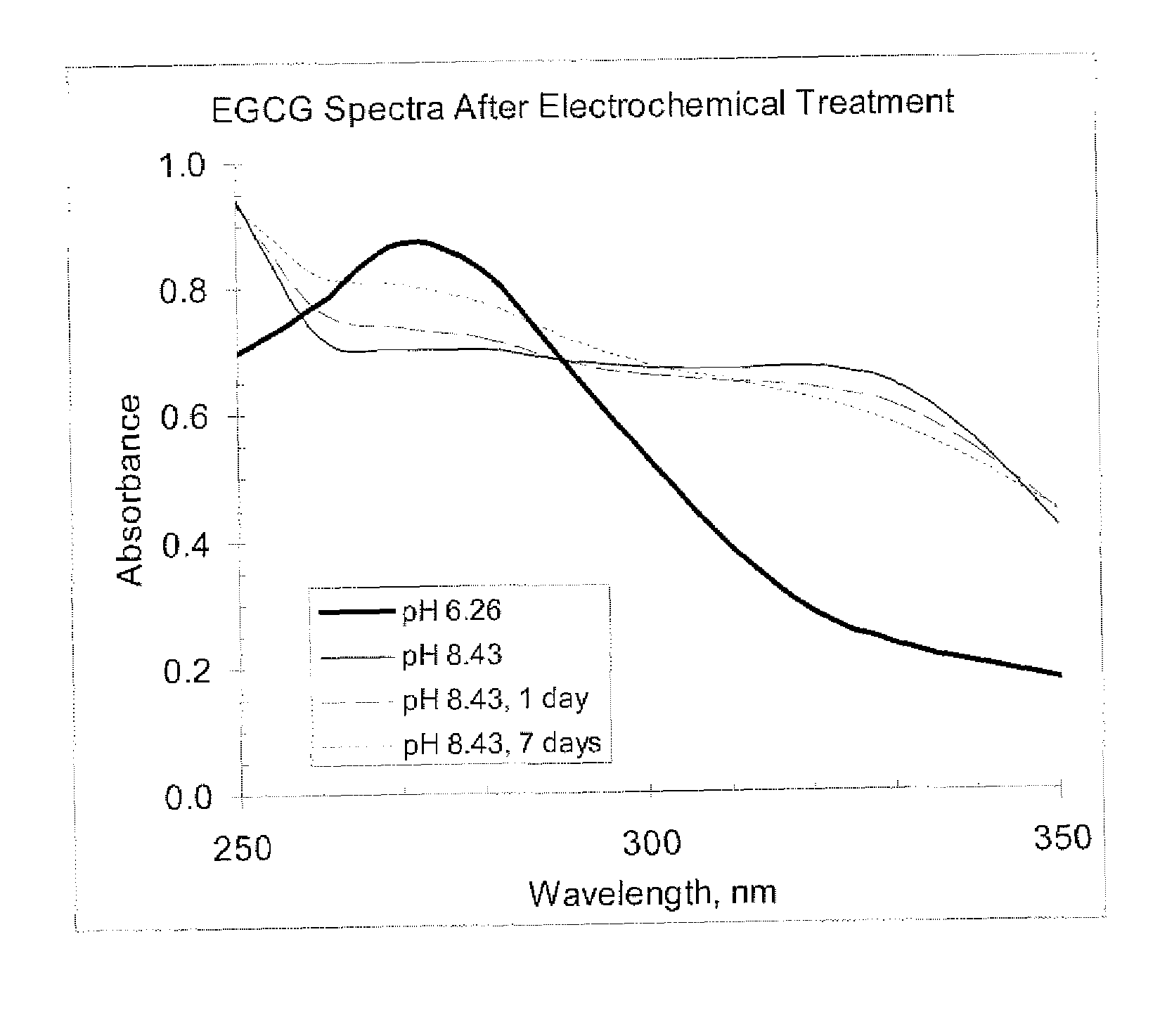Electrochemical methods for redox control to preserve, stabilize and activate compounds
- Summary
- Abstract
- Description
- Claims
- Application Information
AI Technical Summary
Benefits of technology
Problems solved by technology
Method used
Image
Examples
example i
Analytical Techniques for Compound Measurement
[0057]The structure of most molecules to be investigated incorporates aromatic rings with multiple phenol sites for oxidation. One common example would be epigallocatechin gallate (EGCG), EGCG has two adjacent phenolic groups that can oxidize once to form the semiquinone, and a second time to form the quinone. These three oxidation states are the dominant forms under physiological conditions.
[0058]The phenolic material can be monitored using a UV absorbance of the solution with appropriate blank. Phenols with moderate conjugation typically have strong UV absorbance in the 260 to 280 nm region; EGCG has an absorbance peak at 272 nm. Direct comparison of standard solutions to formulation solutions with increasing degrees of oxidation will be indicated by a corresponding decrease in relative reduced phenol concentration.
[0059]The quinone is the second oxidation product. In the case of EGCG, adjacent phenolic groups yield adjacent quinones. ...
example ii
Electrochemical Oxidation, Storage and Activation
[0061]To ensure that a medicinal preparation of the present invention is in a preferred or desired redox state at the time of manufacturing, storage and administration, the preparation can be initially manufactured electrochemically and then stored in a container (e.g., bottle or intravenous delivery bag) with a battery. This battery may be activated at the time of administration or, more preferably, before administration. Any medicinal preparations can thus be electrochemically oxidized or reduced at any stage prior to or at the time of administration.
[0062]In order to stabilize a compound, substance or preparation, a constant voltage is applied to the medicinal formulation, this formulation comprising either or all of the following; compound(s), substance(s) or preparation(s). Alternatively, an electrical potential can be applied at the time of dispensing from the bottle or applicator.
[0063]For topical applications, the medicinal fo...
example iii
Oxidation States as Measured Electrochemically
[0065]The multiple oxidation states of the molecule of interest can also be determined electrochemically. In the case of EGCG, the molecule can be cycled repeatedly through the various oxidation states. This electrochemical technique is called cyclic voltammetry. The first phase involves applying an excessive positive potential (oxidizing potential) and oxidizing all the species present to one form. Then the applied voltage is stepped down in increments while monitoring current. When the redox potential of a reaction is approached, molecules begin to be reduced, causing current through the circuit. After returning all molecules to the reduced form, the voltage is increased and the redox potentials of the reaction(s) are recorded.
[0066]Additionally, the open circuit potential of the solution versus a standard reference electrode can be measured. This method utilizes two electrodes, working and reference, to determine the electrochemical p...
PUM
| Property | Measurement | Unit |
|---|---|---|
| Electric potential / voltage | aaaaa | aaaaa |
| Surface area | aaaaa | aaaaa |
Abstract
Description
Claims
Application Information
 Login to View More
Login to View More - R&D
- Intellectual Property
- Life Sciences
- Materials
- Tech Scout
- Unparalleled Data Quality
- Higher Quality Content
- 60% Fewer Hallucinations
Browse by: Latest US Patents, China's latest patents, Technical Efficacy Thesaurus, Application Domain, Technology Topic, Popular Technical Reports.
© 2025 PatSnap. All rights reserved.Legal|Privacy policy|Modern Slavery Act Transparency Statement|Sitemap|About US| Contact US: help@patsnap.com



